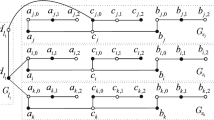Abstract
For a connected graph \(G = (V, E)\), a subset F of E is an edge dominating set (resp. a total edge dominating set) if every edge in \(E-F\) (resp. in E) is adjacent to at least one edge in F, the minimum cardinality of an edge dominating set (resp. a total edge dominating set) of G is the edge domination number (resp. total edge domination number) of G, denoted by \(\gamma '(G)\) (resp. \(\gamma '_t(G)\)). In the present paper, we study a parameter, called the semitotal edge domination number, which is squeezed between \(\gamma '(G)\) and \(\gamma '_t(G)\). A semitotal edge dominating set is an edge dominating set S such that, for every edge e in S, there exists such an edge \(e'\) in S that e either is adjacent to \(e'\) or shares a common neighbor edge with \(e'\). The semitotal edge domination number, denoted by \(\gamma ^{'}_{st}(G)\), is the minimum cardinality of a semitotal edge dominating set of G. In this paper, we prove that the problem of deciding whether \(\gamma ^{'}(G)=\gamma ^{'}_{st}(G)\) or \(\gamma _t^{'}(G)=\gamma ^{'}(G)\) is NP-hard even when restricted to planar graphs with maximum degree 4. We also characterize trees with equal edge domination and semitotal edge domination numbers (Pan et al. in The complexity of total edge domination and some related results on trees, J Comb Optim, 2020, https://doi.org/10.1007/s10878-020-00596-y, we characterized trees with equal edge domination and total edge domination numbers).











Similar content being viewed by others
References
Arumugam S, Velammal S (1998) Edge domination in graphs. Taiwan J Math 2:173–179
Dahlhaus E, Johnson D, Papadimitriou C, Seymour P, Yannakakis M (1994) The complexity of multiterminal cuts. SIAM J Comput 23(4):864–894
Haynes TW, Hedetniemi ST, Slater PJ (1998a) Domination in graphs: advanced topics. Marcel Dekker, New York
Haynes TW, Hedetniemi ST, Slater PJ (1998b) Fundermentals of domination in graphs. Marcel Dekker, New York
Horton JD, Kilakos K (1993) Minimum edge dominatting sets. SIAM J Discrete Math 6(3):375–387
Karp RM (1972) Reducibility amongcombinatorial problems. In: Miller RE, Thatcher JW (eds) Complexity of compute computations. Plenum Press, New York, pp 85–104
Kilakos K (1998) On the complexity of edge domination, Master’s Thesis, University of New Brunswick, New Brunswick, Canada
Kulli VR, Patwari DK (1991) On the edge domination number of a graph. In: Proceedings of the symposium on graph theory and combinatorics, Cochin. Publication, vol 21. Centre for Mathematical Sciences, Trivandrum, pp 75–81
Lru CL (1968) Introduction to combinatorial mathematics. McGraw-Hill, New York
Mitchell S, Hedetniemi ST (1977) Edge domination in trees. Congr Numer 19:489–509
Muddebihal MH, Sedamkar AR (2013) Characterization of trees with equal edge domination and end edge domination numbers. Int J Math Comput Appl Res 3:33–42
Pan Z, Yang Y, Li XY, Xu S-J (2020) The complexity of total edge domination and some related results on trees. J Comb Optim. https://doi.org/10.1007/s10878-020-00596-y
Srinivasan A, Madhukar K, Nagavamsi P, Pandu Rangan C, Chang MS (1995) Edge domination on bipartite permutation graphs and cotriangulated graphs. Inf Process Lett 56:165–171
Topp J (1993) Graphs with unique minimum edge domination sets and graph with unique maximum independent sets of vertices. Discrete Math 121:199–210
Xu B (2006) Two classes of edge domination in graphs. Discrete Appl Math 154:1541–1546
Yannakakis M (2006) Edge-deletion problems. SIAM J Appl Math 154:1541–1546
Yannakakis M, Gavril F (1980) Edge dominating sets in graphs. SIAM J Appl Math 38:364–372
Zhu EQ, Liu CJ (2019) On the semitotal domination number of line graphs. Discrete Appl Math 254:295–298
Acknowledgements
We would like to thank the referees for their remarkable suggestions and comments on our manuscript. This work was funded in part by National Natural Science Foundation of China (Grants Nos. 11571155, 11201205, 11901263).
Author information
Authors and Affiliations
Corresponding author
Additional information
Publisher's Note
Springer Nature remains neutral with regard to jurisdictional claims in published maps and institutional affiliations.
Rights and permissions
About this article
Cite this article
Pan, Z., Li, X. & Xu, SJ. Complexity and characterization aspects of edge-related domination for graphs. J Comb Optim 40, 757–773 (2020). https://doi.org/10.1007/s10878-020-00622-z
Published:
Issue Date:
DOI: https://doi.org/10.1007/s10878-020-00622-z




